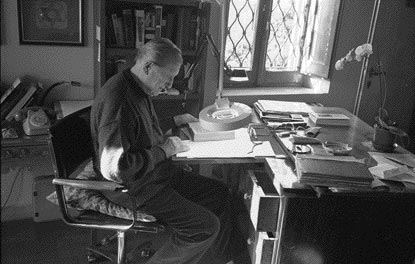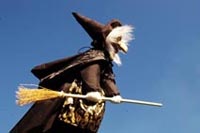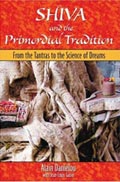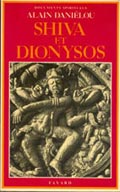EDITO

Alain Daniélou, Zagarolo, Rome, Février 1991. Photo Sophie Bassouls
Apologies for this long delay in sending our winter solstice newsletter. Since this period is full of feast days, however, we shall place it under the sign of a thoroughly pagan Roman festival, known as the “Befana”. This curious corruption is a transformation of the word “Epiphany” by dissolute Romans into the “Befana”, personified by a strega – a witch – wearing a black shawl, flying on her broomstick to bring gifts (yet more gifts, after those of St Nicolas, Christmas and New Year, without forgetting Halloween) or lumps of coal – the latter for disobedient or lazy children! The recent proposal to suppress this joyous and popular feast day raised such protest that it had to be reinstated!
Together with this letter, you will find the various projects envisaged to commemorate the one hundredth anniversary of Alain Daniélou’s birth, which will in some way be the climax of my activities in this field. Indeed, the target I fixed (the publication of all Alain Daniélou’s writings) is about to be achieved, and since I don’t think I shall be around for his 200th anniversary in 2107….
However, during the next few years, I shall do my best to promote the “Semantic”, the instrument for micro-tonal music based on Alain Daniélou’s theories on the subject. The 40-minute composition by the composer Igor Wakhévitch is an excellent vehicle for this purpose, and we are also expecting compositions from Jacques Dudon and Luigi Esposito.
With regard to the works of Alain Daniélou, since nobody’s perfect, in two of his texts he makes a mistake in identifying two different political movements. Indeed, in “A Brief History of India” published by Inner Traditions in 2003 and in his autobiography “The Way to the Labyrinth” published in 1987, two books that have been continually reprinted and also translated into other languages since their original publication in French, he attributes to the Indian monk Swami Hariharanand Sarasvati, better known by the name of Karpatri, the foundation of a political movement, the Jana Sangh, whereas he had actually founded a movement called Ram Rajya Parishad, with different ideology.
Although the books in question have been published for nearly a quarter of a century, it is only in the last few years that this mistake has been noticed, upsetting certain Indian circles who came to know about it through the recent English edition of the first book – A Brief History of India (Inner Traditions International, Rochester, USA, 2003).
As soon as this was discovered, I naturally requested the publishers to insert an erratum in the books involved, which they will do starting from the next reprinting. In the meantime, the Italian version of the autobiography – La Via del Labirinto – published in 2004 by Casadei Editore, Padua, already contains this correction, which will also be included in the Spanish translation, to appear within a few months at Barcelona (Kairos Edition). This letter also contains the correcting entry drafted by the Doctor of Literature Jean-Louis Gabin, whose collaboration with the Daniélou Centre concludes with the appearance of the fifth volume “Kama et Yoga” of the collection “The Mleccha’s Exercise Books”.
Good news from Belgium: the Molière bookshop in Charleroi reports on the success of the exhibition “Lumières de l’Inde”, demonstrated by its four-month extension, up to the beginning of 2007.  The exhibition will then be moving on to the Charleroi municipal library “Marguerite Yourcenar” (Château de Cartier, place Albert 1er, 38 à Marchienne-au-Pont Hainaut – Tel 0032 71/86.56.27).
The exhibition will then be moving on to the Charleroi municipal library “Marguerite Yourcenar” (Château de Cartier, place Albert 1er, 38 à Marchienne-au-Pont Hainaut – Tel 0032 71/86.56.27).
Returning to the Befana, let us all celebrate this popular pagan festival with gaiety and rejoicing!
Jacques Cloarec
ACTUALITÉS
– The Alain Daniélou Centenary Year (1907-2007)
Projects
Publication of 8 books/3 compositions for the Semantic/5 Exhibitions/Concerts/4 Seminars in Inda, Spain and Italy.
Publication of « Shiva and the Primordial Tradition » Inner Traditions International (Rochester USA), published in December 2006.
Publication of “Il Tamburo di Shiva” in Italy (Casadeilibri Publishers, Padova, January 2007)
Presentation : Rome University February 2007
Publication of “The Way to the Labyrinth” in Spanish (Kairos Publishers, Barcelona: Spring 2007)
Presentation at Casa Asia in Barcelona and at the Maison de l’Inde at Valladolid
Publication of “Shiva and Dionysus” in Japanese, Kodansha Publishers , Tokyo.
Publication of “Tour du monde en 1936”, with drawings and photos
Exhibition and sale of Alain Daniélou’s drawings in France/Spain/Belgium/Italy, including the Maison de l’Inde in Paris
Exhibition of photos of China, Japan, India
Publication of “Musiques et danses de l’Inde Traditionnelle” (Michel de Maule Publishers, Paris, September 2007)
Exhibition fof the photos from the same book
Concerts of Songs by Tagore
Publication of the scores of Tagore’s songs in February (Michel de Maule Publisherss, Paris, February 2007)
Reprint of “Sémantique Musicale” (Hermann Publishers, Paris)
Presentation of the Semantic and the work created by the composer Igor Wakhévitch
Presentation of the composer Jacques Dudon’s composition currently in progress
Presentation of the composer Luigi Esposito’s composition currently in progress and the existing score.
Seminar on the Semantic at the Thoronet starting from January 2007
Conference at the Cini Foundation in Venice, Institute of Venice and the Orient (October 2007)
Seminars in India of the Work of Alain Daniélou
Internet Sale of Alain Daniélou’s watercolours and drawings
Complete recasting of the site ‘alaindanielou.org.
Installation in Paris of an aerial for the Rome Daniélou Centre.
EN LIBRAIRIE
Shiva and the Primordial Tradition
Inner Traditions International, Rochester, 2006.
Collection edited and presented by Jean-Louis Gabin, Translation by Kenneth F. Hurry.
From Publishers Weekly :
 Better known in Europe than in the U.S., the late French intellectual Daniélou (1907–1994) forged an eclectic career spanning several disciplines, though he is best known for his work on Indian music and culture. As a convert to the Hindu denomination known as Shaivism (which worships the god Shiva as the supreme being), Daniélou broke the rule of objectivity in his study of Hinduism, which has hurt his standing in academia. For the spiritual seeker, however, his work is immensely valuable in bridging the gap between polytheistic Hinduism and Western monotheism. One theme overarches: monotheism is the soul of error, both in the West, which has been “hardly interested in anything but philosophies infected by this germ,” and in the East, where keepers of the “primordial” traditions have sought to ward it off. According to Daniélou, the healing power of Shaivism lies in opening oneself up to the divine spark in all things. More specifically, he shows how the disciplines of yoga and tantric sex, familiar to many in the West, derive from this ancient tradition and are doorways into a deeper and more fulfilling life. As is clear from this slight volume, Daniélou’s Shaivic pluralism has much to say to our increasingly war-torn and materialistic culture and deserves a wide audience. (Jan.)
Better known in Europe than in the U.S., the late French intellectual Daniélou (1907–1994) forged an eclectic career spanning several disciplines, though he is best known for his work on Indian music and culture. As a convert to the Hindu denomination known as Shaivism (which worships the god Shiva as the supreme being), Daniélou broke the rule of objectivity in his study of Hinduism, which has hurt his standing in academia. For the spiritual seeker, however, his work is immensely valuable in bridging the gap between polytheistic Hinduism and Western monotheism. One theme overarches: monotheism is the soul of error, both in the West, which has been “hardly interested in anything but philosophies infected by this germ,” and in the East, where keepers of the “primordial” traditions have sought to ward it off. According to Daniélou, the healing power of Shaivism lies in opening oneself up to the divine spark in all things. More specifically, he shows how the disciplines of yoga and tantric sex, familiar to many in the West, derive from this ancient tradition and are doorways into a deeper and more fulfilling life. As is clear from this slight volume, Daniélou’s Shaivic pluralism has much to say to our increasingly war-torn and materialistic culture and deserves a wide audience. (Jan.)
Copyright © Reed Business Information, a division of Reed Elsevier Inc. All rights reserved.
À PARAÎTRE
– The bookstore Arthème Fayard announces the coming translation and publication of Shiva and Dionysus by the Publishers Kodansha of Tokyo.
 For Alain Daniélou, the West has lost its own tradition and has estranged humankind from nature and the divine. Here he shows us that the rites and beliefs of the ancient western world were very close to Shaivism and can be easily comprehended through the texts and rites preserved by India. It is the relatively recent religions of the Aryan and Semitic world – Judaism, Christianity, Islam and Communism – that have alienated humankind from the rest of creation and from a multi-millenary religious and mystic experience whose tradition has been preserved in India down to our own times, which the West – if it wants to survive – must rediscover.
For Alain Daniélou, the West has lost its own tradition and has estranged humankind from nature and the divine. Here he shows us that the rites and beliefs of the ancient western world were very close to Shaivism and can be easily comprehended through the texts and rites preserved by India. It is the relatively recent religions of the Aryan and Semitic world – Judaism, Christianity, Islam and Communism – that have alienated humankind from the rest of creation and from a multi-millenary religious and mystic experience whose tradition has been preserved in India down to our own times, which the West – if it wants to survive – must rediscover.
Shiva et Dionysos, Fayard, Paris, 1979 (jacket).
ERRATUM
Mr Alvaro Enterria, director of the publishing house Indica Books of Varanasi writes: “I feel we should not give western labels too lightly to Indian political movements, which take place in a very different universe”. This is exactly what Daniélou states in a letter dated 15 February 1983 to Monsieur Alain de Benoist, Chief Editor of Nouvelle Ecole. “Having lived so long in a different civilisation, my points of view on many levels – social, ethical, religious, philosophical – are difficult to classify according to western categories”. I therefore feel it best not to issue or transmit in this letter any judgement on the ideology of Indian political movements in the ‘fifties.
The following is an abstract of Dr Jean-Louis Gabin’s draft concerning the mistake made by Alain Daniélou in two of his works: – A brief History of India, p. 315 and 335, at Jana Sangh – The Way to the Labyrinth, p. 152 and 185, at Jana Sangh
Alain Daniélou, who took part in the setting up of the Dharma Sangh cultural movement, inspired by Swami Karpâtri, is confusing the Ram Rajya Parishad (Council of the Kingdom of Ram), traditionally inspired political party founded also by Swami Karpātri in 1948 and the Jana Sangh, founded in 1951, forefather of the current B.J.P.
For more details, see the postface of the Cahier du Mleccha n° IV, Approche de l’hindouisme, Kailash Editions, 2004.
EXTRAITS
– Venice, le 13 Avril 1972 :
Venice is not a ice place to live. The climate is awful and the city very provincial. For me the country around Rome remains what I like best in Europe. The climate is moderate. There is a big city near by, direct air connections to anywhere.
The people are friendly. The South of France is overcrowded and french administration trouble some if you want to be a resident. as far as Switzerland where everything is easy, the country is rather boring and it rains most of the time.
All depends on what one expects of life and how many months in a year one expects to stay.
M. Gayelord Hauser, Taormina (Italy)
– Venise Le 3 Octobre 1979 :
My work on Hindu Polytheism is based entirely on traditional sources. I asked questions to the most authoritative traditional scholars in every field and they gave their answers in writing. These answers were published in the Hindi monthlies Siddhant and Sanmarg between 1945 and 1950, in Benares and sometimes in the Hindi montly Kalyan from Gorakhpur. There is a special number of Kalyan, the Shakti ankha of over two thousand pages which contains a large number of articles by the most authoritative scholars including a long article on the significance of the Mahavidyas Chinnamasta in particular an also other articles on Chinnamasta with illustrations. This was published around 1938. It contains also a Woodroffe article in Hindi. There is a copy of this volume in my collection of books and manuscripts which I have given to the Cini Foundation in Venice (Italy). Someone able to read Hindi or Sanskrit could arrange there to have photocopies made. The present librarian cannot do it and I rarely go there myself now. It may be that the special numbers of Kalyan are to be found in the U.S.A. somewhere though I have doubts. At the time the Tantra texts in manuscript form were occasionally loaned to me but I could not keep them.
The most likely place to find Tantra manuscripts (few are published) would be in the Sanskrit College Library in Calcutta, probably in Bengali script. They have an old catalogue. My work on Hindu Polytheism was done more than 30 years ago and none of the scholars consulted spoke English.
Your tracing the origins of the Shakti cults to the Rig Veda does not seem correct. Shiva and Shakti cults existed in India before the Aryan invasion and were gradually incorporated, from surviving tradition into the vedic religion. Hence the late date and poor Sanskrit of the available Tantric texts and the concept of Veda enlarged to a sort of universal cosmic law of which the Vedic texts are considered to reflect only a fragment.
Mr. Walter Smith, Iowa (États-Unis)
CLIN D’OEIL
ALICE BONER (1889-1981)
« Uday’s older brother, Ravi Shankar, had had a rather interesting career. The son of a highranking Bengali official, he had come to Paris to study painting. Pavlova, who was trying at the time to create an oriental ballet, took an interest in this boy who knew nothing about dance but had a great of imagination. He helped choreograph the ballet, which turned out to be very poor. It was here that he met Alice Boner, a Swiss woman from Zurich who had inherited a large fortune in industry. Alice took an interest in this very handsome Indian youth and decided to take him back to India so that he could devote himself entirely to dance. Alice was a beautiful woman of about thirty-five, tall and stately, haughty and strong-willed. She rather reminded me of Juno. She was also quite a good painter. She began to track down any surviving evidence of Indian classical dance, which was very much looked down on in Anglo-Indian cultural circles as were all the other traditional arts.
Alice was the first person to discover the great art of Kathakali dancing, which still existed in a few forgotten villages in the state of trichur in Kerala, in southeast India. She encouraged a local poet called Vallathol to bring together the best of the surviving masters of this remarkable art, and helped him found the Kerala Kala mandalam, the famous school of Kathakali, in the village of Chiruthuruthi. The school later became one of the greatest glories of India. It was she who discovered, helped, and supported the two splendid Bharata Natyam dancers, Bala Saraswati and Shanta Rao; she also knew many musicians, especially the famous Alla ud din Khân.
<……..> While living in Benares, Alice grew passionately interested in the aesthetics and symbolism of Hindu architecture and sculpture, which led her to the study of ancient texts. She collected a large number of manuscripts, but since she knew only a few words of Sanskrit, she enlisted the help of a few Indian scholars to translate them for her. She discovered unknown treatises of exceptional significance and, many years later, published some of these texts as well as her internationally famous studies on the architecture of temples, the best-known being her work on the construction techniques of the gigantic temple of Konarak. »
Alain Daniélou, The Way to the Labyrinth, Memories of East and West, New Directions, New-York, 1987.
– Alice Boner Diaries (India, 1934-1967) page 121
Luitgard Soni and Jayandra Soni, Eastern Book Corporation, New Delhi, 1993.
August 11, 1945, Almora (Himalaya)
Yesterday Alain Daniélou came to see me and I incidentally mentioned that I felt so desperately tired everytime I went up to Townshend in Kasar Devi Estate. I said I did not know why this particular walk exhausted me so much, though it was not such a very long one. He quickly said : « It is the Devi ». I looked at him somewhat bewildered.
So he went on and explained to me that at certain points of the earth there are particular stresses caused by superior powers, and that at such places temples are often erected. One ought not to live there, but only go there for worship. People here never go to that Estate without going to the temple and worshipping the Devi. Somehow he reasoning struck me and as I had not visited the Devi I thought it might be true. So at night in bed I concentreted on the Devi and tried to make contact with her. Everything became alive within myself and I started to realize the absurdity of my neglect.
I have been working for weeks now on my composition of Prakriti, but it never entered my mind to even pray to the Devi, to try to approach her, to identify myself with her, as I had done in the case of Vishnu’s Vishvarupa when, in a devotional spirit, I always tried to go beyond manifestation and to visualize the absolute. But the wonder of creation itself, the active manifesting power which had brought forth all these worlds, and was perhaps in the process of destroying them again, I always bypassed it, admiring it perhaps, but never workshipping it. There I found myself in an absolutely new position, face to face with the supreme creative power to whom we all owe our existence. I suddenly began to understand those who worship the Devi and was happy to have in some way seen the way leading to her. I decided to go to the temple with flowers and makes amends for my neglect. In the morning I plucked some roses from the garden and put them in a long boat-shaped vessel which I supposed represented the Devi’s symbol and prayed for her grace and mercy.
After that I worked merrily and felt quite relieved and happy and at noon a note came from Gertrude Sen, announcing the end of the war.

